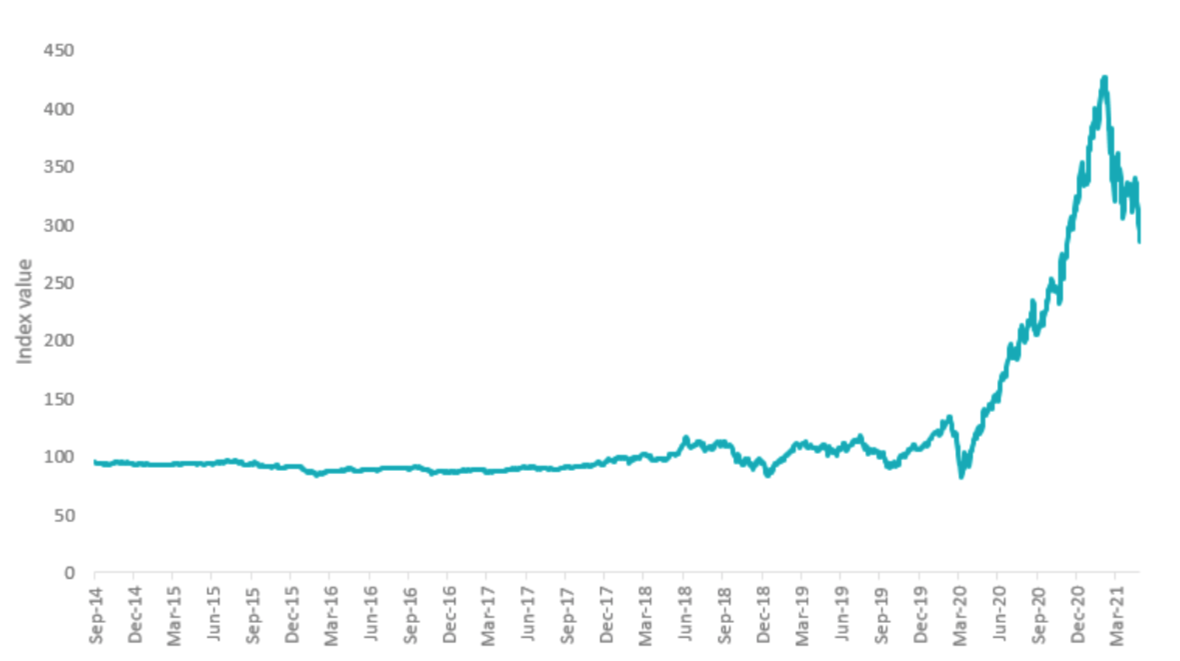‘Til debt do us part
Through bull times and bear times, those investors who stay true to their ‘quality’ principles have reaped the rewards of accumulating wealth and preserving capital.
With the ‘value-rotation’ commencing in late 2021, cyclicals and those securities deemed ‘value’ have experienced strong returns. More recently however, those investors who stayed true to ‘quality’ rode through the value-trade with strong returns.
Ultra accommodative interest rates and gargantuan fiscal stimulus has meant the world is still on the debt binge it has been on for some time now. Coming into COVID-19, corporate balance sheets - especially in the US - were holding considerable amounts of debt. Now with net debt to GDP ratios even higher and central banks reticent to intervene, any stress or unexpected event threatening to compromise the credit party and could be a catalyst for market volatility.
The Goldman Sachs Non-Profitable Technology Index soared from March 2020 into the start of the year, but since February 2021 it has crashed 32%.
If timing a crisis is shy of genius, then picking the next global mega tech is beyond brilliant. There is no doubt some of the stocks in the Goldman Sachs Non-Profitable Technology Index will become profitable and successful. But there are many that will not.
Think about the longest bull market in history following the GFC, those tech companies that drove the market’s returns were Apple, Alphabet, Microsoft and Facebook, companies with stable earnings and that weren’t burdened with debt. These are quality companies.
The current macro environment
Central banks and governments around the world have been doing all they can to stimulate economies. Given record low rates are expected, for at least the medium term, many companies have taken advantage by issuing more and more debt. Figure 1 below shows that US corporate debt to GDP is now sitting at all-time-high levels. The rise of credit is unprecedented. The last time credit cycles peaked, based on a similar incline (pre-GFC), share markets collapsed.
Figure 1: US Total Credit to Non-Financial Corporations as a % of GDP
At the same time corporates have been leveraging the share prices of companies with ‘negative earnings’, which until very recently, have been skyrocketing. The Goldman Sachs Non-Profitable Technology Index, often referred to as the ‘negative earnings’ company index, rose exponentially from a low in March 2020 to a record-high in February 2021. As remarked earlier, it has since fallen over 30%, which should give investors time for pause.
Figure 2: The Goldman Sachs Non-Profitable Technology Index

Available data from 10 Sept 2014 to 7 May 2021. The calculations for the above include the reinvestment of all dividends but do not include fees and other costs with an investment. Source: Goldman Sachs, Bloomberg.
Quality may outperform
While low rates have encouraged companies to take on more risk, economic growth among developed countries isn’t matching equity market enthusiasm. US jobs growth also unexpectedly slowed in April. The economic recovery, unlike the share market recovery, is not going to be rapid. In a low growth environment, companies that traditionally do well have the following characteristics:
- Value creating return on equity (ROE) – a ROE above 15%
- Attractive growth profile – above average earning per share (EPS) growth
- Sustainable earnings – demonstrated across multiple business cycles
- Strong balance sheets – gearing ratios ~50% with strong net cash positions
The MSCI World ex-Australia Quality Index (Quality Index) only includes the 300 highest quality scoring stocks determined by MSCI based on three easily identifiable financial characteristics:
- High ROE;
- Stable year-on-year earnings growth; and
- Low financial leverage
Figure 3: Quality Index characteristics
Performance in bull and bear markets
Over the long term, the Quality Index has demonstrated outperformance. Notably, the Quality Index has significantly outperformed in previous down market environments such as the GFC bear market and periods of low rates and low inflation, as the chart below shows.
Figure 4: Quality Index performance
For bearish investors, negative outcomes or the potential for losses are the ‘risks’ they consider. A measure called ‘drawdown’ is useful for investors to assess this risk. It demonstrates both the depth of a fall from an historical peak and the pace of the recovery to a new peak. The maximum drawdown is the distance from the highest peak to the deepest valley. Investments that fall less and recover faster are more desirable.
The chart below shows the drawdown of the Quality Index versus the broader MSCI World ex Australia Index (‘benchmark’) for the past 15 years, capturing the GFC. In summary:
- The maximum drawdown of the Quality Index was -24.28% versus the benchmark’s much bigger fall of 37.79%
- The pace of recovery of the Quality Index
was eight months faster than the benchmark.
Figure 5: Drawdown 1 May 2006 to 30 April 2021 (%)
Never miss an insight
Enjoy this wire? Hit the ‘like’ button to let us know. Stay up to date with my content by hitting the ‘follow’ button below and you’ll be notified every time I post a wire.
Not already a Livewire member? Sign up today to get free access to investment ideas and strategies from Australia’s leading investors.
4 topics

